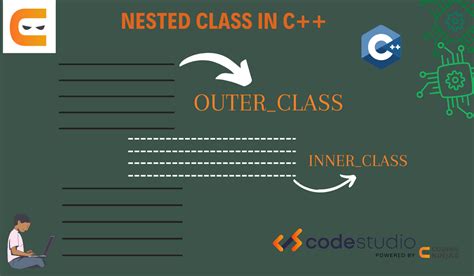Introduction
In the realm of object-oriented programming, encapsulation reigns supreme as a fundamental principle. It shields the implementation details of a class from the outside world, offering enhanced security, reduced coupling, and increased code maintainability. One effective encapsulation technique involves the use of nested classes in C++, which enables the creation of inner classes within the scope of an outer class.

Nested classes provide a convenient and structured approach to organizing and managing related functionality within a single logical unit. They offer several advantages, including:
- Improved encapsulation and data hiding
- Enhanced modularity and code organization
- Reduced coupling between classes
- Support for scoping rules and access control
Types of Nested Classes
C++ offers two primary types of nested classes:
-
Static Nested Classes: These classes are declared within the scope of another class using the
statickeyword. They are independent of any instance of the outer class and can be accessed using the scope resolution operator (::). -
Non-Static (Member) Nested Classes: These classes are declared within the scope of another class without using the
statickeyword. They depend on an instance of the outer class and can be accessed using the dot operator (.).
Applications of Nested Classes
Nested classes find diverse applications in various domains, including:
-
Event Handling: Nested classes can be used to define event handlers for specific events. This allows for more efficient and organized event management.
-
Thread Safety: By encapsulating state and behavior within nested classes, thread safety can be achieved in multithreaded environments.
-
Data Association: Nested classes can be used to create logical associations between related data, enhancing data encapsulation and reducing redundancies.
-
Design Patterns: Nested classes play a crucial role in implementing design patterns such as the Iterator pattern and the Visitor pattern.
-
Enhancing Modularity: Nested classes enable the creation of self-contained modules that can be easily reused or extended.
Advantages of Nested Classes
Utilizing nested classes in C++ offers numerous advantages:
-
Improved Encapsulation: Nested classes provide enhanced data hiding by encapsulating related methods and data within a single logical unit.
-
Code Organization: They promote code organization by grouping related functionality into logical blocks, leading to improved readability and maintainability.
-
Reduced Coupling: Nested classes reduce coupling by limiting the direct interactions between different classes, promoting loose coupling and increased flexibility.
-
Enhanced Access Control: Access to nested classes can be controlled based on their scope, allowing for more granular control over data access.
Considerations and Limitations
While nested classes offer significant benefits, it’s essential to consider the following limitations and considerations:
-
Increased Complexity: Nested classes can potentially increase code complexity if not used judiciously. Excessive nesting or unnecessary use of nested classes can lead to confusion and difficulty in understanding the code structure.
-
Name Conflicts: It’s important to carefully consider the naming of nested classes to avoid potential conflicts with other classes or members within the same scope.
-
Inheritance Issues: Non-static nested classes cannot inherit from classes outside the scope of the outer class, which can limit their extensibility.
-
Performance Implications: Nested classes may have slight performance overhead compared to their non-nested counterparts due to the additional layer of indirection.
Tips and Tricks
To effectively utilize nested classes in C++, follow these best practices:
- Use nested classes sparingly and only when they provide clear benefits.
- Consider the scope and access needs of nested classes carefully.
- Name nested classes thoughtfully to avoid name conflicts.
- Leverage non-static nested classes for implementing design patterns.
- Test nested classes thoroughly to ensure their correctness and efficiency.
Conclusion
Nested classes in C++ offer a powerful mechanism for organizing and encapsulating code, enhancing modularity, and improving code maintainability. By understanding their types, applications, advantages, and limitations, developers can effectively leverage nested classes to create robust and maintainable C++ applications.
